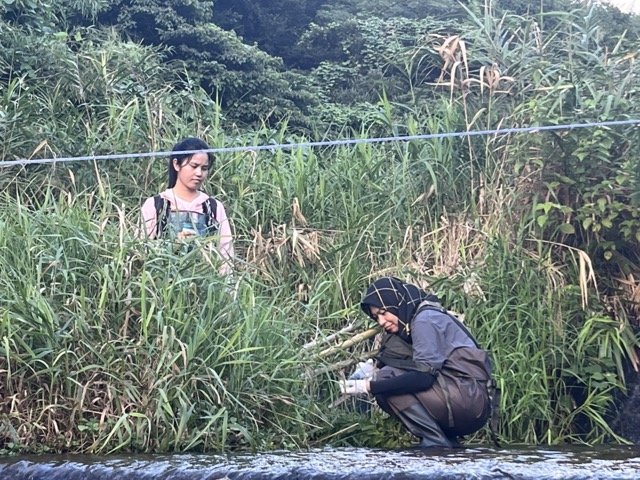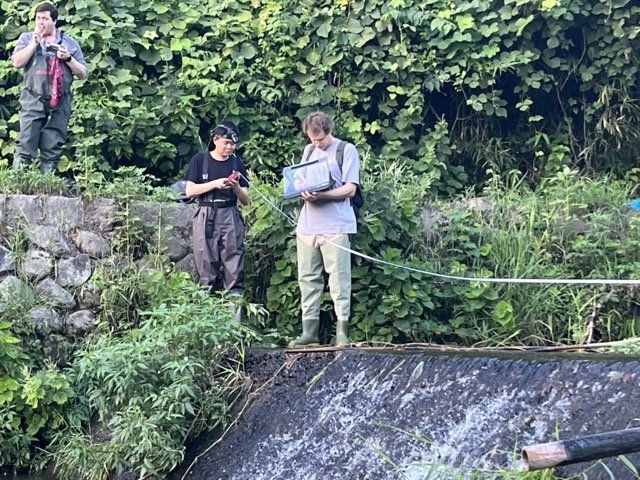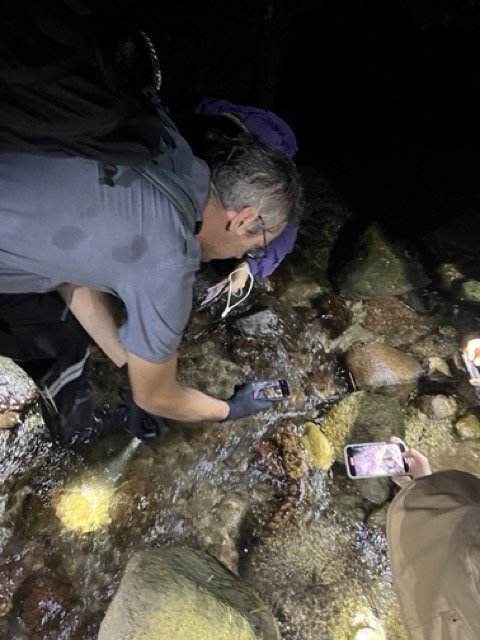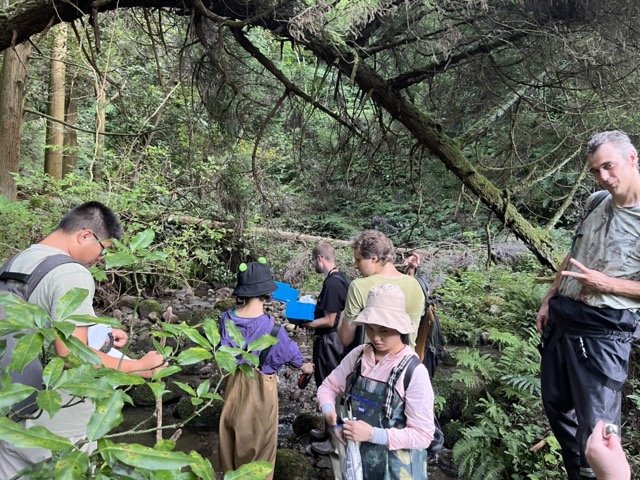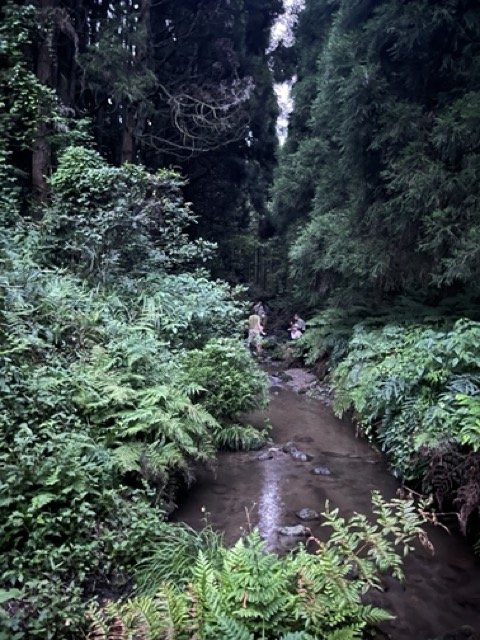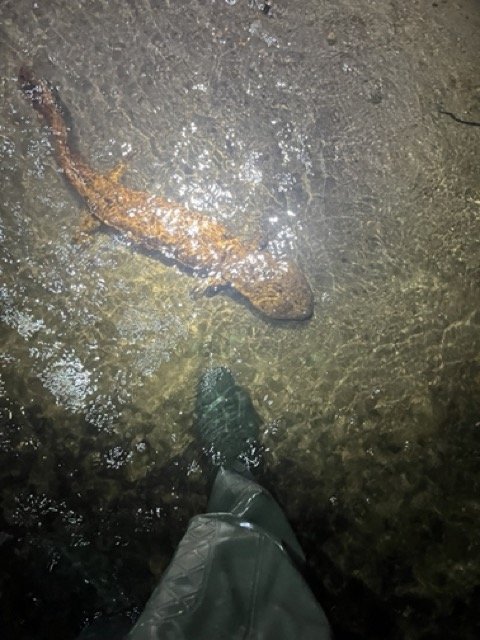World-leading researchers join Sustainable Daisen to survey the rivers of Daisen Town
World-leading researchers and students from several countries joined us to survey the rivers of Daisen Town and try to help save the Japanese giant salamanders and other wildlife in and around them! Sustainable Daisen is taking the lead in Japanese giant salamander conservation!
When Kazumi and I set out on our mission a couple of years ago to save the Japanese giant salamanders of the Nawa River Basin in Daisen Town, it soon became clear that we couldn’t rely on anyone to help our cause, especially the local authorities and local groups which had been tasked with conserving and protecting them. The lack of research and practical conservation work to understand help the giant salamanders was especially shocking. It was almost at zero.
Simply put, if we don’t understand what the true situation is for the animals of the area, we can’t possibly act effectively to preserve and protect them. In fact, the local authorities have cited a lack of data as a reason for their lack of practical action yet are not making any attempts to conduct research themselves . It doesn’t suit them to know the truth: no data equals no evidence of a problem.
Our mission was clear, we needed to facilitate the research ourselves and we required the help of international experts in order to make it as impactful as possible. However, what transpired last month was beyond our initial dreams as 16 of the world’s top and most respected amphibian researchers and students came to join us in Daisen. Led by Professor Amaél Borzēe from the IUCN SSC Amphibian Specialist Group, the group also consisted of Professor Kevin Messenger of the IUCN SSC Viper Specialist Group, artificial nest box specialist Jordy Groffen, MSc. and Dr. John Abernethy, Lecturer in Ecology and Environmental Sciences at Liverpool John Moores University.
Together we conducted surveys including eDNA tests for the presence of invasive Chinese giant salamanders, extensive water quality surveys to determine the level of pollutants present, drone surveys to check for suitable habitats, and recording all of the Japanese giant salamanders we came across as well as all other species of fauna.
This group of wildlife heroes were inspiring and filled me with hope for the future. We worked something in the region of 18 hours a day (and night) for ten days straight.
Together we experienced the very best and the very worst of the area. We all got scratched, cut, bruised and bitten countless times by the unforgiving plants and insects of the region. We waded through heavily polluted, stomach turning animal farm runoffs and crawled through 100 metre pipes in the early hours of the morning. Despite all of this the group remained positive and fixed on the goal of surveying the river basin as effectively as possible in order to help all of the wildlife within it. Additionally, most of the costs were borne by the researchers themselves and by the kind donations of supporters of Sustainable Daisen.
I can not thank these defenders of nature enough. It is my duty to make sure this research really counts for something. I promise you that it will and already is.
世界をリードする研究者や学生たちが各国から集まり、大山町の川を調査し、日本のオオサンショウウオやその周辺の野生動物を救うための活動に参加しました。「サステナブル大山」は、日本のオオサンショウウオ保護の先頭に立っています!
和美と私が数年前に名和川流域のオオサンショウウオを救うために使命を帯びて活動を始めたとき、すぐに地元の機関や団体の支援に頼ることはできないことが明らかになりました。これらの機関は生物を保護し、守る任務を負っていましたが、オオサンショウウオの理解と実践的な保護活動の実績はほとんどゼロに近く、それは驚くべきことでした。
この地域の生物の正しい状況を理解しない限り、効果的に保護することはできません。地方自治体は、実践的な行動を起こさない理由としてデータ不足を挙げていますが、自ら調査を行おうともしていません。真実を知ることは彼らには不都合なのです。データがないので問題の証拠がないというのが彼らの立場です。
私たちの使命は明確でした。私たちは調査を進め、できるだけ影響力を持たせるために国際的な専門家の協力を求めました。そして、当初の夢を遥かに超えることが先月現実となりました。世界のトップかつ最も尊敬される両生類の研究者と学生16人が、私たちと一緒に大山を訪れました。それはIUCN SSC両生類専門家グループのアマエル・ボルゼー教授、IUCN SSCヴァイパー専門家グループのケビン・メッセンジャー教授、人工巣箱の専門家ジョーディ・グロッフェン氏、およびリバプールジョンムーアズ大学の生態学と環境科学の講師ジョン・アバネシー博士を含むグループでした。
私たちは一緒に、侵略的な中国オオサンショウウオの存在を調べるためのeDNAテスト、汚染物質のレベルを確認するための包括的な水質調査、適切な生息地を確認するためのドローン調査、出会ったすべてのオオサンショウウオと他の動植物の記録を含む調査を行いました。
この野生動物を守る英雄的グループは、私を感動させ、未来に希望を持たせました。私たちは10日間連続で、日中(そして夜も)約18時間もの活動を行いました。
彼らと共に、この地域の最高と最悪を経験しました。私たちはこの厳しい植物や昆虫によって何度も傷つけられ、切り傷や打撲傷を負い、何度もかまれました。私たちは重度に汚染された動物農場の排水を踏み越え、早朝に100メートルのパイプを這いつくばり移動しました。それでも、私たちはグループができる限り効果的に川流域を調査し、その中のすべての野生動物を助けるという目標に尽力しました。さらに、ほとんどの費用は研究者自身と「サステナブル大山」のサポーターからの寄付によって賄われました。
これらの自然を守る方々たちには、感謝の意を表しきれません。この研究が本当に何かのために役立つようにするのは私の責任です。それは既に効果を上げていますし、今後もそのようになることをお約束します。




